Fishes are vertebrates that are gill-bearing aquatic animals. One of the most beautiful creations of nature, blend of different color and pattern make them beautiful.
Fishes are classified into several categories. In recent times, fish have been quite popular among humans as a pet. The major categories in which fishes are divided are Freshwater and Saltwater fishes.
This article will help you to decide which freshwater fish to choose for your home aquarium.
Contents
List of 25 Freshwater Aquarium Fish (2023)
Fish make truly a great pet for the people who don’t have time and physical space to devote to a pet with high maintenance. Moreover, we can also use the fish as a starter pet for children so as to teach them the responsibilities of a pet.
They are known to provide a calming effect on the one who sees them. Also, they come in a variety of shapes and vibrant colors.
Moreover, some types of fish can communicate with their owners with signs. A fish can be taught tricks too. Thus making them an easygoing pet for home.
1. Cherry Barb
It is a freshwater fish, slender in stature, and comes in three colors (black, white, scarlet).
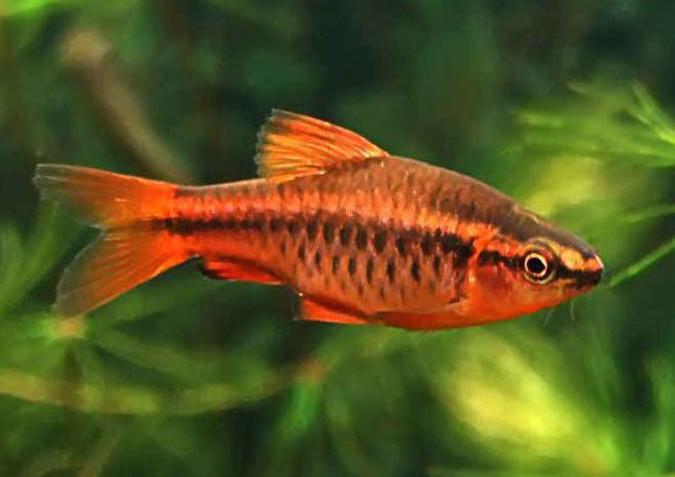
Description:
Cherry Barb, comes from the broad “Barb” category of fish. Fish is slender in shape with a compressed body, they can grow up to 5 cm in length.
The creature is a native of Sri Lanka country. It is fawn-colored on top and slight green at sheen its sides and belly have. The male is redder in color than the females.
Behavior:
The behavior of Cherry Barb is peaceful. One can keep them with other fish.
Food:
This fish is omnivore by nature, so it can eat both algae and meaty food. Fish can also take dried food such as shrimp, also freeze food.
Lifespan:
The life expectancy of this fish is around 5-7 years in ideal conditions, which may increase or decrease with the condition of the habitat
Aquarium Size:
One can use an aquarium of 20 gallons so that they can wander easily in the aquarium.
2. Betta
Discovered in SouthEast Asia, making its ground in the rice paddies and ward floodplain of the region. Through cyclic changes these fish developed the ability to intake oxygen directly from the air as well as from its gills, becoming a true labyrinth fish, thus making them self-sustainable in oxygen-deficient water.
The long flashy tail is an attraction for all.

Description:
The name of this fish “Betta” comes from an ancient clan of warriors, called the “Bettah”. Generally beta fish comes in small size, but they can range considerably from 2.5 cm to 12.5cm in length.
These creatures are anabantoid, making them inhale oxygen from the air as well as from their gills inside the water. The one thing that makes them more peculiar is their vibrant color, also their tail shape.
Betta have various tail shapes-“veil tail”, moreover other tail shapes include “short-finned fighting-style tail”, “crown tail”, “double-tape”, and ,”half-moon”.
Behavior:
As their name is given after the ancient clan of a warrior, they reflect the same nature. However, there is variation in behavior of both male and female betta.
Male betta will adapt well to the community tank given that there is no other betta present in the tank. On the other hand, females exhibit more of get together behavior, as long as there is no new one placed in the tank.
Food:
Betta feeds primarily on the water surface, they are an omnivore in nature. A good diet includes brine shrimps, bloodworms, tubifex worms, betta pellets. The nutrition from this food help betta to increase the longevity and improve various coloring.
Betta cannot survive on plant root they need high vitamin food in order to show growth.
Lifespan:
The life expectancy of Betta Fish is 3-5 years in captivity. Provided good living conditions and healthy food their lifespan can be increased.
Aquarium Size:
Use tank size of more than 5 gallons, bigger the thank size more will be the chances of fish to thrive-bigger the better. Filter the water on a regular basis use a gentle water filter for filtration, also avoid plastic plants and use live plants.
Moreover betta fish tend to come out in the light, provide a stable schedule for day and night. Leave the gap at top of the tank so that betta could come at the surface of the water.
3. Neon Tetra
Featuring among the famous freshwater aquarium fishes, Neon Tetra is small in size and like to live in a group. They are fast in maneuvering from one place to another so they will take every single empty space in your tank.
This vibrant fish is one of the oldest tropical fish, they are one of the easy and sought after fish the reason being is because of their calm temperament and easy care.
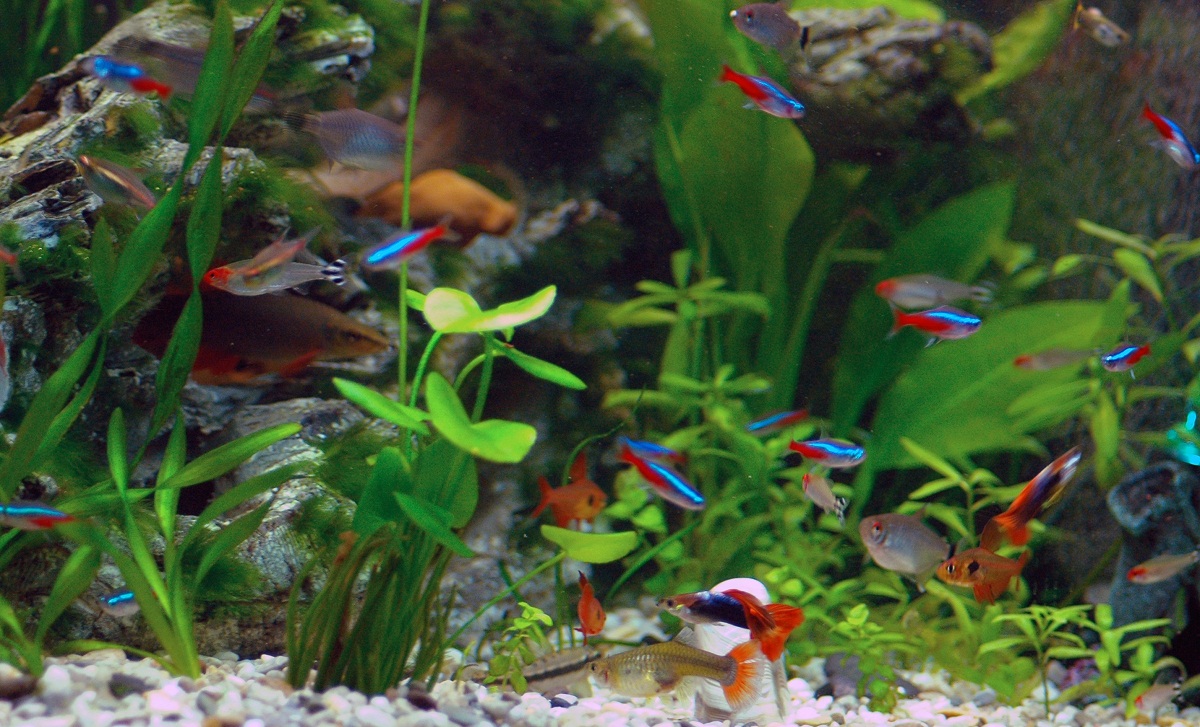
Description:
Neon Tetra is a freshwater fish and comes from a characin family, it can grow up to 3 cm in length. They are native to black water and clear water stream and are found in the basin of river Amazon in South America.
The bright color of the fish makes it visible in the dark water too. Tetra is considered the jewel of the water, with blue bodies and bright red tail.
When kept in groups these creatures creates a beautiful splash of colors. As a native to South America, these fish prefer densely planted system with plenty of low lights.
Food:
Omnivore by nature, neon tetra can eat anything that fits in their mouth. This does make feeding these fish easy and simple. In their natural habitat neon tetra feeds upon algae, green larva, small vertebrates. Given food can be; medallions, blanched zucchini, flake food.
I would suggest using Hikari Micro Pellets, this food is really good as its nutrition value is very high. Also, frozen food can also be given to fish as a feast, it prefers bloodworm, brine shrimp, daphnia.
Lifespan:
The life expectancy of neon in ideal cases is about 6-8 years. If good tank conditions and good nutrition are provided then the fish can live up to 10 years. Some cases have reported a lifespan of 12 years.
Aquarium Size:
For beginners tank size of 20 gallons for the fish is good. The large tank size will allow the fish to move easily and give them space to thrive. Furthermore, a large tank makes it easy to take care of the environment.
An aquarium with a small size will result in water change more frequently and change in pH of water making it unsuitable for your tetra.
4. Kuhli Loach
Also known as Coolie Loach, Kuhli Loach is a native to Tropicals water of Indonesia, Malaysia. This creature resembles an Eel and is very slender and nocturnal in shape. brown to black vertical bars work as a signature.
However, a distinction between males and females is not readily apparent, closer inspection reveals that males have a rather strong jaw compared to females. Khuli Loach tends to inhabit the slow-flowing stream or river.
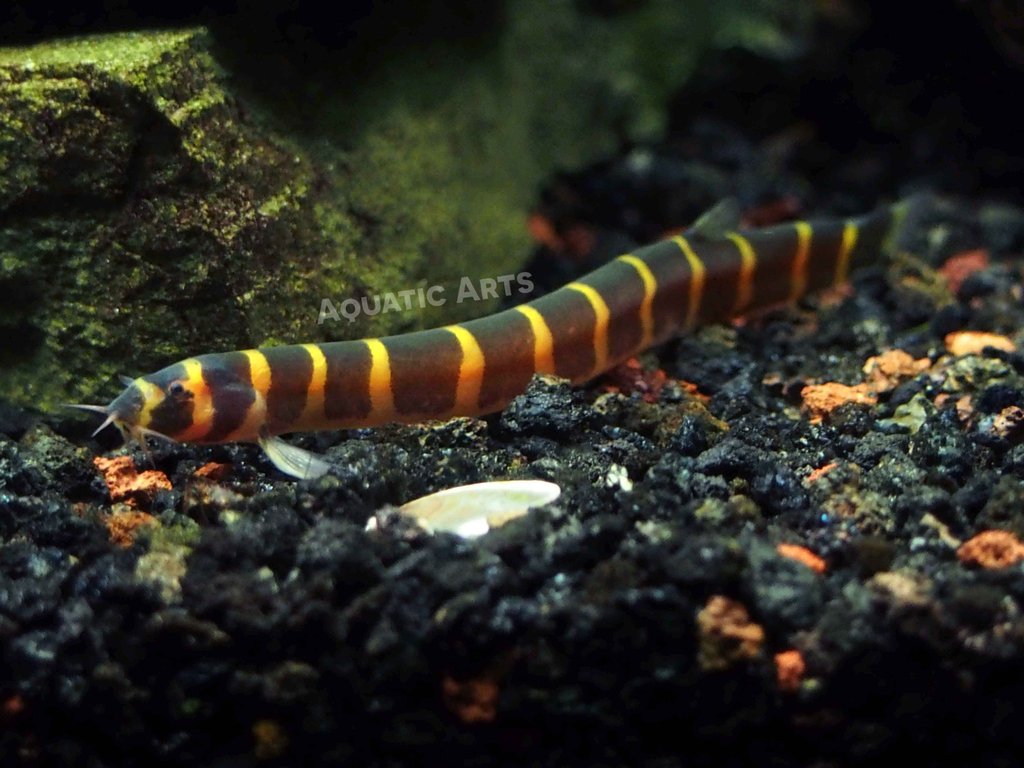
Description:
Khuli loach is an eel shape fish that comes from the Loach family. It has a slightly compressed side and 4 pairs of barbels around the mouth. This creature is known as a bottom feeder fish, it will feed anything on the bed of the water or bottom of the aquarium.
Loach is calm by nature and is kept in a school of 3. It reaches maturity at 2 ¾ inches (7 cm) and has a maximum length of 4 inches (10 cm).
Many fish can be kept with Khuli because of their calm temperament, it should be taken care of not to include fish that can take them as food.
Khuli loach feeds at night and hides during the day.
Food:
Khuli Loach is a scavenger in the wild, and because of this, they will feed on anything given to them in the aquarium. To ensure their healthy diet, we must feed them in combination with frozen food.
These fish mostly feed during night time so ensure to feed the fish after switching off the light. When it comes to frozen food, fish enjoy bloodworms, daphnia, brine shrimp, and blackworms.
Lifespan:
The lifespan of this fish is around 10 years in normal conditions. However, if proper care is taken then they can live up to 12-14 years.
Aquarium Size:
The Khuli Loach has an advantage over other loaches as it never grows too much. It is not demanding fish and can thrive well in an area of 20 gallons. However, Anything less than that would not be suitable for them.
Apart from that, we have to make sure to keep these fishes in a pair of 3 or 4. Because they are social by nature and keeping them alone would make them stressful. Furthermore, they also may go into permanent hiding.
We should keep them in larger groups which will allow them to exhibit more natural and playful behavior when there are more of them.
5. Sword Tails
The Sword Tails is a species of freshwater fish and comes from Poeciliidae. This fish comes in different color and have a quite unique type of fins commonly known as Red swordtails or Green swordtails.
They are livebearers which means that the baby fish come out free swimming.
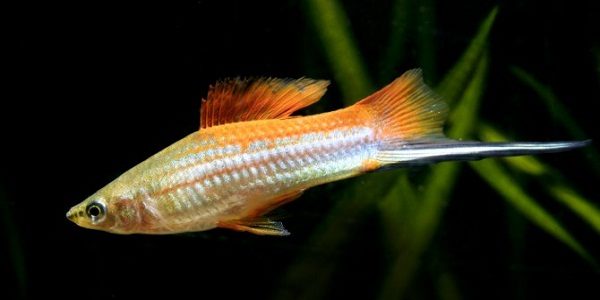
Description:
The Sword-Tail fish is a freshwater fish and is an inhabitant of North America. It is one of the most popular fish among the people. Easy to maintain, it is very much compatible with the diverse environmental condition.
We can easily keep it in a variety of water conditions. There is variation in size among the male and female, males are slightly smaller than female. Females can grow up to 6.3 inches and male 5.5 inches.
Food:
Sword Tail is omnivore by nature. Which makes them accept any kind of food. Swordfish eat algae and greens in their natural habitat.
One can give them quality flake food or bloodworms. Don’t neglect to mix proper herbivore food in their diet.
Lifespan:
The lifespan of this creature is around 3-5 years in normal conditions. But, with food and habitation, we can increase life expectancy.
Aquarium Size:
One can use an aquarium of up to 10 gallon.
6. Angelfish
Angelfish is the most common name for Pterophyllum scalare, one of the most common fish kept as pets.
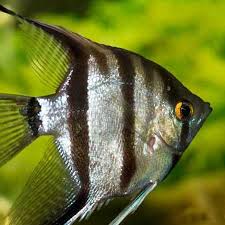
Description:
Angelfish are natively from the Amazon Basin in Columbia, Brazil, and Peru. The fish live in swamps or water-filled grounds with dense vegetation. The water conditions range from pH 6 to 7. It can bear temperature up to 75 to 86 °F.
Behavior:
They are territorial to some extent, mainly if you have placed 2 mated pairs together in a tank. One pair may act defensive towards the other, at times.
Food:
The angelfish eat younger fish, prawns, or worms. It may also feed on mosquito larvae. This way the fish intakes a high protein and nutritious diet helping in a notable growth and better reproductive cycles.
Lifespan:
An angelfish may survive for about 10 years or more.
Aquarium Size:
You may put 2-4 angelfishes in a 30-50 gallons tank.
7. Longfin Zebra Danio
There are many variations of Danio rerio fish. The Longfin Zebra Danio is one of those with dark blue stripes.
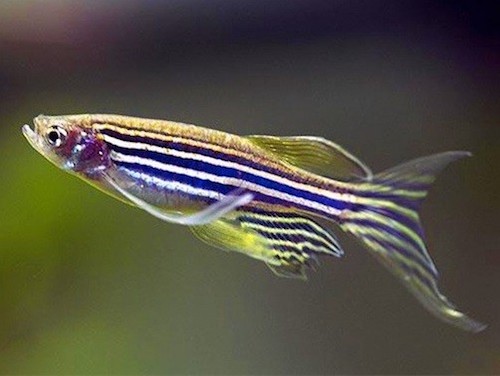
Description:
The Zebra danio is a freshwater fish from the minnow group of aquatic, natively from South Asia. It is also known for its capability to regenerate body parts.
Zebra Danios live in moderately flowing or stagnant shallow water of streams, ditches, canals, ponds, and rice paddies.
Behavior:
Zebrafish is found to have episodic memory, related to objects, locations, and events. They are popular, especially for their playful nature and fast-breeding. These fish can easily be kept in a group as they interact well with other fish species.
Food:
Zebra danios are omnivores. They mainly eat phytoplankton or zooplankton insects and insect larvae. They may even feed on worms and baby crustaceans their preferred food options aren’t available. Adult zebrafish are also fed with brine shrimps.
Lifespan:
The average lifespan of zebrafish in captivity is 42 months.
Aquarium size:
The reason being the Zebra Danios are tiny, they can be kept in just a 10 gallons tank.
8. Mollies
Mollies belong to the Poecilia Sphenops species of the Poecilia genus. They are generally dull or silvery in color.
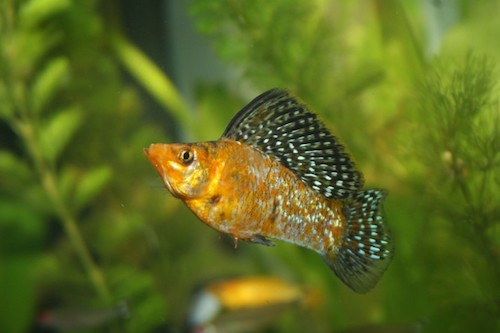
Description:
Mollies live in freshwater rivers and spend some time into coastal waters too, before returning to freshwater streams. Mollies can produce many hybrids with the Poecilia species.
They are the most popular fish used as feeder fish (fed to sharks, or other larger fish). Mollies come in several varieties like black molly, white molly, golden molly, balloon molly, and a few more.
Behavior:
The male mollies are found to be aggressive.
Food:
Mollies are omnivores and they survive on small invertebrates, algae, and aquatic plants. They can be fed with high-quality flake food or different types of vegetables.
Lifespan:
Mollies can live for about three years in an aquarium
Aquarium size:
10 Mollies can be kept in a 29 gallons tank. Moreover, it is better to keep a ratio of 2 females per 1 male.
9. Jack Dempsey
Rocio Octofasciata, because of its aggressive nature and tough facial features, is named Jack Dempsey fish after a famous boxer of the 1920s.
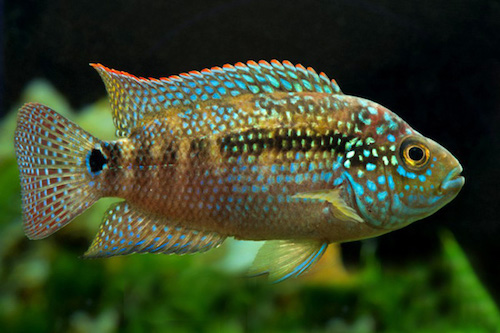
Description:
Natively Mexican, Jack Dempsey can be found in warm silty canals, drainage ditches, and slow-flowing rivers. Water with a pH of 6-7, the hardness of 9–20 dGH, and temperature 22–30 °C is suitable for the Jack Dempsey fish.
Behavior:
The fish is aggressive like other cichlids however can be accommodated along with other fish. Jack Dempsey is mostly shy and territorial.
Food:
Jack Dempseys are carnivorous. They eat worms, insects, crustaceans, and other fish.
Lifespan:
Jack Dumpsyes live for seven to ten years.
Aquarium size:
A minimum of 65 gallons tank is recommended for a pair of Jack Dempsey.
10. Oscar
Astronotus ocellatus (Oscar) natively comes from Peru, Colombia, Ecuador, Brazil, and French Guiana. Found in the river basins and river drainages.
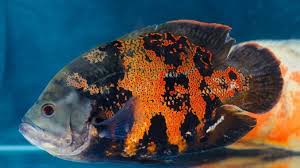
Description:
Oscars live generally in slow-flowing white-water territories. They are mostly found hidden under submerged branches. They live in warmer climates as the species cannot tolerate temperatures cooler than 12.9° C.
Behavior:
Oscars can swiftly change their colors as a manner of showing territorial and combating behaviors. It mimics death to trick its prey and uses suction to capture it.
Food:
Oscars are fed the food meant for large fishes – crayfish, worms, insects (flies, crickets, and grasshoppers).
Lifespan:
An oscar fish lives for 10 to 20 years.
Aquarium size:
A 29 gallons water tank for each Oscar is recommended.
11. Guppy
Guppies from Poeciliidae family and the native of South America, are now found all over the world. They can survive in different habitats and environmental situations.
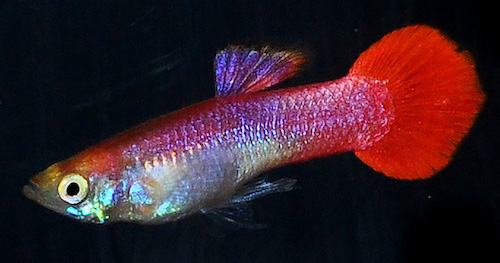
Description:
Guppies prefer hard water with a temperature of around 23° C – 27° C, however, they can withstand salinity of normal seawater.
Behavior:
Guppies are generally peaceful, though they may get aggressive towards other male guppies, angelfish or some Xiphophorus. Never put Guppies alone in the tank, as they shoal and like staying in large groups.
Food:
Wild guppies usually eat different types of food including benthic algae and aquatic insect larvae. They are found to switch diets as per scarcity in the wild. You can feed live food such as baby brine shrimp, micro worms, infusoria, and vinegar eels.
Lifespan:
Guppies may live for 1-3 years.
Aquarium size:
You can keep 5 guppies in 10-20 gallons tank.
12. Pictus Catfish
Pictus Catfish, natively from Amazon and Orinoco river basins, are the small (up to 11 cm) members of the catfish family.
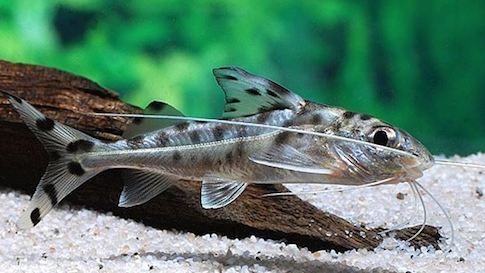
Description:
Pictus Catfish have extremely long barbels like their other counterparts. The fish have black spots and stripes on the silver body. They live in freshwater and can bear temperature to 72° F – 77° F.
Behavior:
The Pictus Catfish are nocturnal (night eaters), bottom feeders (feeds-on near the bottom part of the body), and very fast swimmers. They don’t show territorial behavior, hence, can be kept with other Pictus catfish.
Food:
These fish inside tanks, being omnivorous favor bloodworms, beef hearts, insects, vegetables, and ready-to-eat fish foods. They may eat smaller fish like neon tetras.
Lifespan:
Pictus Catfish can live for 4-8 Years.
Aquarium size:
Pictus Catfish require large tanks as they are enthusiast swimmers.
13. Variatus Platy
Variatus Platy is a freshwater species from the Poeciliidae family. These live-bearers are the native of north-eastern Mexico.
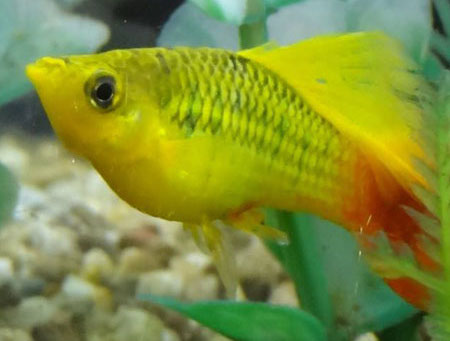
Description:
Variable Platyfish have colorful patterns. These fish can survive in comparably cooler waters between 16° C – 24° C.
Behavior:
These mostly habitat vegetated waterways, trenches, and warm springs
Food:
They are omnivorous. Their diet includes both plants and small crustaceans, insects, and annelid worms.
Lifespan:
An average lifespan of 3 years is noticed.
Aquarium size:
You can place 4-6 Platies(with a ratio of 2 females per 1 male) in a 15 gallons tank.
14. Pearl Gourami
Natively from Southeast Asia, Pearl Gourami a species of gourami, have a brownish-silver body-color, covered by a pearl-like design.
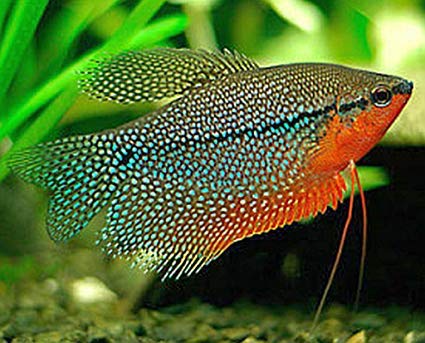
Description:
The pearl gourami likes to stay at the top and middle levels of the water. The fish can stay in temperature between 22° C – 28° C.
Behavior:
Pearl Gourami fish are territorial. The fish may be a little shy, hence, avoid putting them together with aggressive fish. These fish might exhibit intense shyness initially. They like hiding most of the time.
Food:
The Pearl Gouramis are omnivores. These fish can be fed with all kinds of living insects, fresh, or flake foods.
Lifespan:
Pearl Gourami lives for about 5 years, sometimes more if cared well.
Aquarium size:
A tank with a capacity of 29 gallons is adequate for a pair of Pearl Gourami.
15. Green Swordtail
Xiphophorus Hellerii as known as Green swordtails belong to the Poeciliidae family. They can be found in freshwater or brackish water.
Description:
Green Swordtails are closely related to platyfish and they are natives of North and Central American stretching till Mexico. They are called swordtails because the male fish has a sword-shaped lower lobe. They can tolerate temperatures between 21-28 °C.
Behavior:
The green swordtail fancies active flowing rivers with dense vegetation, also seen in warm springs and waterways.
Food:
Green Swordtails are omnivores and prefer to eat plants, small crustaceans, annelids, insects, and worms.
Lifespan:
These can live up to 3-5 years
Aquarium size:
A minimum of 29 gallons tank is required for a pair of green swordtails.
16. Silver Dollar Fish
Metynnis argenteus, famous as Silver Dollar Fish, belongs to serrasalmid endemic species. Their nativity is Tapajos River Basin in Brazil.
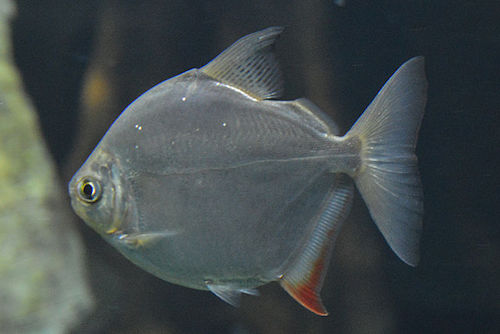
Description:
These fish can survive in temperature between 24–27 °C. They can lay up to 1000 eggs, hence, avoid putting the male and female silver dollars together.
Behavior:
Silver Dollars are lively and very peaceful shoaling fish. They need to stay in a shoal with plenty of space to swim and decorations to hide behind. They stay well in warm, clear, and filtered water and can be kept with smaller fishes.
Food:
Silver Dollars are mainly omnivores but like feeding on plants mostly. They like dried flake food as well as live or frozen foods. You can also provide them with cucumber, shelled peas, carrots, boiled potatoes, and small chunks of fresh tinned fruit.
Lifespan:
They survive for about 10 years.
Aquarium size:
These fish require space so an 80 gallons tank is recommended.
17. Harlequin Rasbora
The Harlequin Rasbora (Trigonostigma heteromorpha) is a little fish from the Cyprinidae family. Heteromorpha in Greek means – differently shaped. It is named so because it has a lozenge-shaped body.
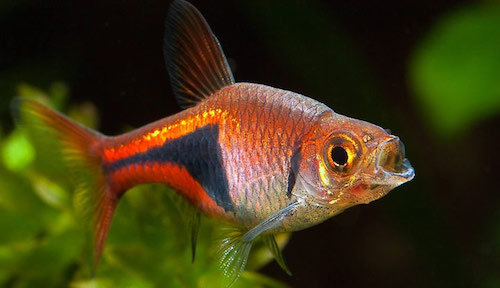
Description:
The fish can live in temperature ranging from 21 °C to 28 °C. Rasbora adores live plants in the aquarium and needs enough space to swim.
Behavior:
The harlequin rasbora must be kept with a minimum of six fish together as they are peaceful shoaling fish.
Food:
Mosquito larvae and other live foods are liked by these fish.
Lifespan:
The average lifespan of a Rasbora is 5-8 years.
Aquarium size:
About 4-6 fish can be placed in a minimum of 10 gallons tank.
18. Bluefin Notho
Bluefin Notho (Nothobranchius rachovii), is a freshwater killifish from Mozambique.
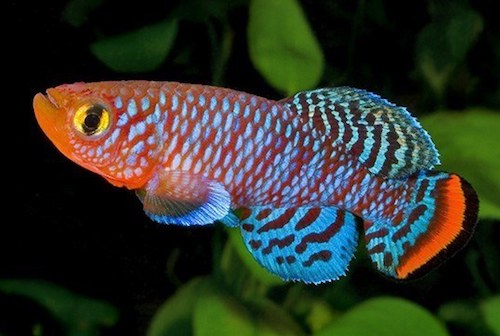
Description:
These fish are commonly found in low-level waters that mostly dry every year. They lay their eggs in mud as the water level decreases, which preserves them until the water returns.
Behavior:
Blue Notho males are very active, however, they are typically territorial and aggressive towards other males of the same species.
Food:
Bluefin Notho fish are benthopelagic – they live and feed near the bottom of the water. They feed on zooplankton and other small lives at the benthos. Avoid giving them dried foods. They survive on live/frozen food such as daphnia, brine shrimp, and bloodworm.
Lifespan:
They survive in captivity for less than a year.
Aquarium size:
They accommodate well in 10–15 gallons water tank.
19. Bolivian Ram
Bolivian Ram (Mikrogeophagus Altispinosus) is a native to Amazon Basin in Brazil and Bolivia, belongs to the Cichlidae family.
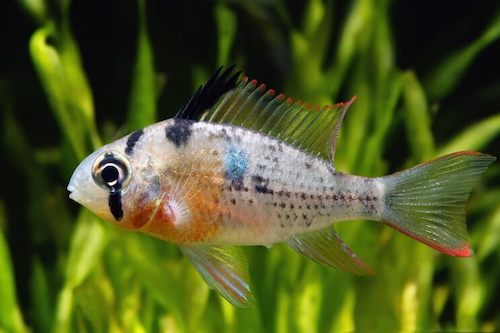
Description:
The fish live in soft, acidic or warm waters and river drainages. Its natural habitat is freshwaters of streams and pools. It can live in temperature between 22–26 °C.
Behavior:
Bolivian Rams swim in a stop-and-go pattern. They are bottom-feeders, hence, they mostly do not go to higher levels of the tank.
Food:
You can give them live or frozen food like bloodworms, blackworms, daphnia, brine shrimps, and food flakes.
Lifespan:
Their average lifespan is up to 4-6 years.
Aquarium size:
About 4-6 Bolivian Rams can be kept in a 20 gallons tank.
20. White Cloud Mountain Minnow
Tanichthys Albonubes, widely known as White Cloud Mountain Minnow is a member of the carp family. These are cold-water fish native to China.
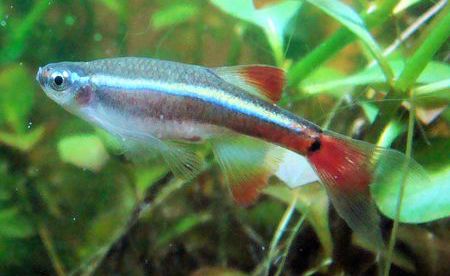
Description:
The fish can survive in water temperatures from 5° C – 22° C. The fish is ideal for places with cold climates.
Behavior:
These fish are quite adjustable with tank temperature and water quality. You must keep a minimum of 5 fish together as these are shoaling fish. If kept alone, it becomes weak. They are peaceful, hence, can be kept with other fish.
Food:
They eat standard flake or pellet food.
Lifespan:
The White Cloud Mountain Minnow may live for 5 Years or more.
Aquarium size:
5 fish can be kept in a tank with 5-10 gallons of capacity.
21. Neon Rainbowfish
The Dwarf or Neon rainbowfish is a rainbowfish species of the subfamily Melanotaeniinae. It is found in Indonesia in the Mamberamo River basin, West Papua.
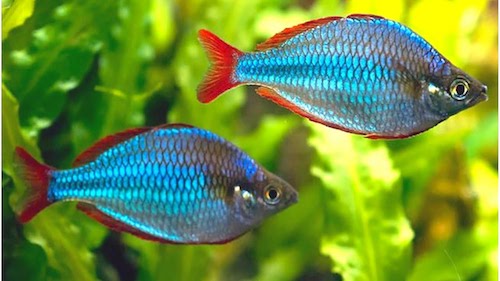
Description:
The neon rainbowfish live in small and slow-flowing streams in areas of rainforest and found in the tropical climate.
Behavior:
These are very active swimmers and are also found to jump out of water. They like schooling in random groups.
Food:
The Melanotaenia praecox are omnivorous fish. They mostly feed on vegetation, insects, small worms and fish eggs.
Lifespan:
A neon rainbowfish can live for 3-4 years.
Aquarium size:
A 20-gallon tank is ideal for 2-4 neon rainbowfish.
22. Sailfin Molly
The Sailfin Molly fish (Poecilia latipinna) live in fresh, brackish or saline water habitats. The species belongs to the Poecilia genus, found in coastal waters of North Carolina to Texas and Yucatan Peninsula of Mexico.
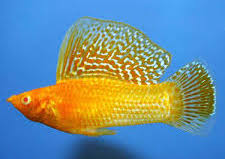
Description:
Sailfin mollies are generally found in shallow waters along the sides of swamps, valley streams, ponds, bays and even in temporary water gatherings of roadside ditches. Also seen under floating vegetations reducing their possibilities of being watched by possible predators.
Behavior:
Sailfin Mollies are not too aggressive but may behave protectively against other fish species. They are active and social and like schooling in groups.
Food:
Sailfin mollies feed upon algae, some plants, aquatic invertebrates, and mosquitoes larvae.
Lifespan:
They have a shorter lifespan of around 1-2 years.
Aquarium size:
Sailfin Mollie grows up to 6 inches and requires at least 29 gallons tank.
23. Goldfish
Goldfish, one of the most common pet fish, is natively from East Asia.
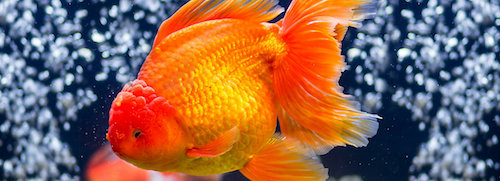
Description:
Varieties of Goldfish differ considerably in size, shape, and colors (white, yellow, orange, red, brown, and black).
Behavior:
Goldfish have good learning skills with great social activeness. They can distinguish between humans, hence recognize their owners. They swim towards the tank glass and swim actively around the tank to interact with the owner.
Food:
They can be fed with small crustaceans, insects, plant matters, green leafy vegetables, and bloodworms.
Lifespan:
Goldfish can live for 5-10 years.
Aquarium size:
For 3-4 goldfish it is recommended to have a 50-60 gallons tank.
24. Kribensis
The Pelvicachromis Pulcher also called Krib, is a freshwater fish of cichlid family found in Nigeria and Cameroon.
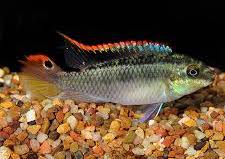
Description:
Kribs live in soft and neutral waters with temperatures between 24–26 °C. They live in both slow and fast-flowing water.
Behavior:
The fish prefer sheltering itself because of becoming prey to many predators in natural habitats.
Food:
They should be fed with diatoms, green algae, pieces of higher plants, and blue-green algae.
Lifespan:
Kribs may live for 5 years.
Aquarium size:
You can put them in a 10 gallons tank. If you are putting them with other fish, prefer bigger tanks as Kribs bound to their territories.
25. Bristlenose Pleco
Ancistrus (Bristlenose Catfish or Pleco), are nocturnal freshwater fish. From the Loricariidae family, Ancistrus are native to South America and Panama.
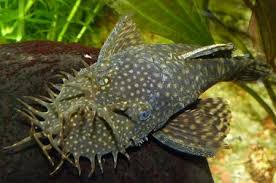
Description:
The Bristlenose is covered in bony plates and has a ventral suckermouth. They are mostly found in rivers and floodwaters of the Amazon basin.
Behavior:
Bristlenose are peaceful fish, however, may prefer protecting their territories when placed with other fishes.
Food:
Ancistrus are omnivorous bottom feeders.
Lifespan:
Ancistrus have a long life of up to 12 years.
Aquarium size:
The tank capacity of 29 gallons is good for a pair of Bristlenose.
The EndNote
We hope that this article on Best Freshwater Aquarium Fishes provided you the information on various freshwater fishes for your home aquarium. We have reviewed 10 such fishes and given the detailed guide to help you select suitable fish as your new pet.
Cheers!

Fish are vertebrates. Invertebrates are creatures without backbones such as snails and crustaceans.
Noted